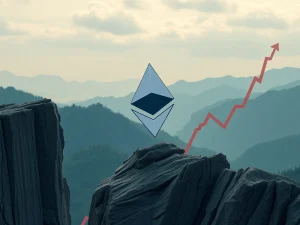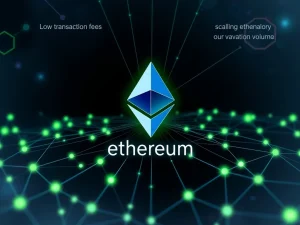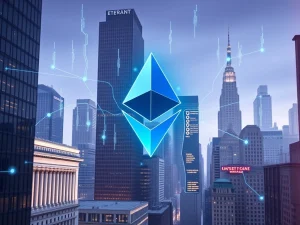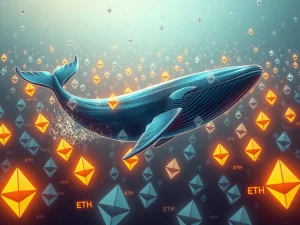Ethereum L2s: Why Thriving Layer 2 Scaling Isn’t Fragmentation

Every few weeks, it seems another Ethereum Layer 2 (L2) solution launches, sparking debate among Web3 commentators. Concerns about fragmentation and an oversaturated market are frequently voiced. Is this rapid proliferation of Ethereum L2s a problem, or is it a sign of healthy growth and innovation? Many argue the latter, suggesting that the future isn’t about chain consolidation but a thriving ecosystem of thousands of specialized L2s, driven by the need for robust Layer 2 scaling.
Understanding Ethereum L2s and Layer 2 Scaling
The core idea behind Layer 2 scaling is to offload transactions from the main Ethereum chain (Layer 1) onto separate networks, processing them faster and cheaper, and then settling the final state back on Layer 1. This approach is crucial for handling the increasing demand on the network. The rapid rise of solutions like zkEVMs and optimistic Rollups is a direct response to the limitations of monolithic chains.
Instead of viewing the launch of a new L2 every 19 days (as one report noted) as a sign of too much activity, consider it an early stage of infrastructure expansion. Just as the internet didn’t stop with a few major websites in the late 90s, the blockchain space is only beginning to explore the potential of specialized networks. The current number of chains is small compared to the potential future landscape.
Addressing Blockchain Fragmentation Concerns
A common criticism of the growing number of L2s is the potential for blockchain fragmentation. Critics worry about liquidity being spread thin and users having to navigate multiple chains. While these are valid concerns in the short term, they overlook the long-term vision and ongoing development in the space.
The proliferation of L2s is not causing the Web3 space to become overly bloated or fragmented in a detrimental way. It’s enabling specialization. Think about traditional industries: banks, social networks, and logistics companies don’t all operate on a single, shared infrastructure. They build or use systems tailored to their specific needs, compliance requirements, and performance demands. The Web3 space is evolving similarly. Large enterprises and institutions, inherently risk-averse, require custom performance, predictable costs, jurisdictional compliance, and granular privacy that general-purpose L1s often cannot provide. They need specialized networks, which L2s are increasingly capable of offering.
The Rise of Modular Blockchains and Specialization
The concept of modular blockchains is key to understanding why more L2s are not only acceptable but necessary. Instead of a single chain handling execution, settlement, consensus, and data availability, modular architectures separate these functions. This allows L2s to specialize in specific areas or use cases.
The surge in L2s is not just a temporary frenzy driven by DeFi users; it’s an enterprise-grade infrastructure expansion. Industries like banking (e.g., Deutsche Bank exploring blockchain), game studios (witnessing significant activity surges on L2s), logistics networks, and global manufacturers are getting involved. These are not entities making casual tech pivots. They are adopting L2s because they need blockchain technology tailored to their complex requirements, regulatory burdens, and contractual needs. Specialized L2s can cater to high-frequency trading while others serve national land registries, coexisting within a broader ecosystem.
How Rollups and ZK Proofs Enable This Growth
Technological advancements, particularly in Rollups (both optimistic and zero-knowledge) and zero-knowledge proof technology, are making the creation of specialized chains increasingly viable. Platforms offering ‘rollup-as-a-service’ are lowering the barrier to entry, making it easier and cheaper for enterprises and developers to spin up dedicated chains.
As the underlying infrastructure improves and costs decrease, we can expect a substantial rise in the number of L2s. These technologies abstract away much of the complexity, much like cloud computing abstracted hardware, enabling hyper-scale for value transfer, asset issuance, and programmable trust. The technical evolution, especially in efficient Rollups and ZK technology, directly fuels the potential for a diverse ecosystem of L2s.
The Future: Interoperability and a Thriving Ecosystem
Concerns about user experience and liquidity dispersion across multiple chains are understandable. However, the space is actively building towards seamless interoperability. Developments in shared settlement layers, trust-minimized bridges, and unified account abstraction are designed to make chain hopping invisible or effortless for the end-user. Ultimately, users will interact with applications without needing to know or care which specific L2 they are on.
Betting against the growth of L2s is, in essence, betting against scale and sovereignty. The future landscape is unlikely to be dominated by a single ‘winner-take-all’ chain. Instead, it points towards hundreds, potentially thousands, of specialized L2s serving distinct verticals, jurisdictions, and use cases, all interconnected as part of one modular, scalable future.
In conclusion, the rapid expansion of Ethereum L2s and the focus on Layer 2 scaling should be viewed as a positive development. It reflects the growing maturity and specialization of blockchain technology, enabling a diverse ecosystem capable of supporting a vast array of real-world applications and enterprise needs. The ‘noise’ about too many chains misses the point: we are just beginning to unlock the true potential of modular, scalable blockchain infrastructure.









